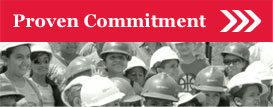Glossary Of Terms
British Thermal Unit (Btu): a standard for measuring energy. A Btu is the amount of energy required to raise the temperature of one pound of water one degree Fahrenheit.
Coke: a hard, dry substance used in the manufacture of iron and steel. It is produced by heating coal to a very high temperature without the presence of air.
Continuous miner: an underground mining machine that removes coal from the face and loads it onto conveyors.
Coking Process: Destructive distillation of coal to make coke A process for thermally converting the heavy residual bottoms of crude oil entirely to lower-boiling petroleum products and by-product petroleum coke.
Conventional mining: a method that includes using explosives in a coal seam, fracturing the seam and removing the coal onto a conveyor or shuttle car.
Dragline: a large, electrically-powered excavating machine used in the surface mining process to remove heavy rock and soils above the coal seam.
Face: commonly used to describe the exposed area of a coal seam from which coal is extracted.
Fossil fuel: a term representing coal, crude oil or natural gas that is formed from the fossil remains of organic material.
Gasification: a process by which coal is converted into low, medium or high-Btu gas.
Highwall: the unexcavated face of exposed overburden and coal at a surface mine.
Kilowatt hour: a unit of electricity measurement. One kilowatt hour equals 1,000 watts of electricity used for one hour.
Longwall miner: a highly productive underground mining process in which a block of coal, sometimes 700-feet wide and a mile or more long, is completely extracted. The working area is protected by a movable powered roof support system.
Overburden: the heavy rock and soil that lie above the coal seam.
Portal: an entrance to a mine.
Preparation plant: a facility that crushes, sizes and washes coal prior to shipment.
Reclamation or Land Restoration: the restoration of land after mining is completed. Federal law requires that mined land be returned to a condition that is equal to or better than before mining occurred.
Roof bolting: a method of supporting the ceilings of underground mines by inserting long steel bolts into holes bored into strata forming the roof.
Scrubber: a device that removes sulfur components formed during coal combustion.
Shortwall: a deep mining method in which small areas are worked by a continuous miner in conjunction with longwall-like hydraulic roof supporters.
Steam coal: coal used by electric power plants and industrial steam boilers to produce electricity.
Surface mine: mining operation where the coal lies near the earth’s surface and can be extracted by removing the covering layer of earth called overburden.
Turbine: machine in which rotating vanes are driven by a steam generator to produce electricity.
Underground mine: also known as a deep mine, which is usually located several hundred feet below the earth’s surface. In an underground mine, coal is removed mechanically and transferred by shuttle car or conveyor to the surface.
Unit train: a long train carrying coal between a mine and its destination.



